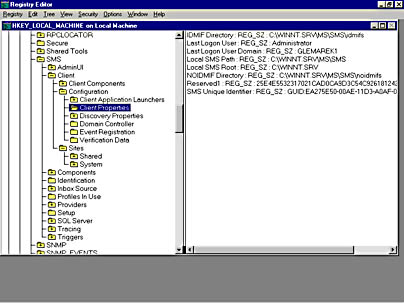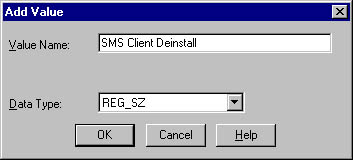Removing Systems Management Server from the Client
At some point, you may need to uninstall SMS from the clients. Removing an individual component is simply a matter of disabling that client agent at the site server. Since client agent settings are sitewide in nature, disabling a client agent at the site server will cause that component to be removed from all clients assigned to that SMS site. There is no way to install or remove client agents on individual clients within the same SMS site.
Your intention, however, may be to remove SMS entirely from all your SMS clients or from individual SMS clients. The easiest way to remove SMS from a large number of clients at one time is to change the site server's site boundaries so that the clients' subnets are no longer represented, meaning that the client is no longer assigned to the site. During the client's next maintenance interval, the SMS components will be uninstalled from the client.
A couple of techniques are available for uninstalling SMS from individual clients. You could run the SMSMan.exe or SMSMan16.exe programs as described earlier in this chapter. Uninstall options are available both through the Systems Management Server Installation Wizard and through command prompt switches. These options can be accessed by connecting to the SMSLogon share on the logon point or by navigating to the System root\MS\SMS\Core\Bin\00000409 folder on the client itself. However, neither of these methods is terribly "clean," meaning that some files are left behind for you to remove yourself.
A more thorough method of uninstalling SMS from the clients is through a registry modification made on the client, as we saw in Chapter 2. To use this method, follow these steps:
- As an administrator, open the client's registry.
- In the Registry Editor, navigate to the HKEY_LOCAL_MACHINE\Software\Microsoft\SMS\Client\Configuration\Client Properties key, as shown in Figure 8-17.
- Select the Client Properties key, and choose Add Value from the Edit menu to display the Add Value dialog box, shown in Figure 8-18. In the Value Name text box, enter SMS Client Deinstall. Leave the Data Type setting as REG_SZ. Click OK to return to the Registry Editor.
- In the String Editor dialog box, shown in Figure 8-19, enter TRUE in the String text box, and then click OK.
- Close the Registry Editor to save your changes.
- From the Control Panel, select the Services applet, select SMS Client Service, and click Stop. After the service has stopped, click Start. The SMS Client Service will read the new registry entry and initiate an uninstall bootstrap process.

Figure 8-17. The Client Properties key in the Registry Editor.

Figure 8-18. The Add Value dialog box.

Figure 8-19. The String Editor dialog box.
Regardless of the method you choose, the uninstall process may take several minutes depending on the number of components installed.
Although the registry method of uninstalling SMS from the client is cleaner than the SMSMan method, you will still have the following cleanup duties to perform:
- Delete the \MS folder. It will be empty, but it is still there.
- Remove the NAL and SMS registry keys under HKEY_LOCAL_MACHINE\Software\Microsoft.
- Remove the SNMP_Events key, if it exists.
- Although not necessary, you can remove the WBEM registry key if no other applications or components require it. This task, of course, would not apply to computers running Windows 98 or Windows 2000.
- Find the Windows\CurrentVersion\SharedDlls key and remove any values related to SMS.
- Find the Windows\CurrentVersion\Uninstall key and remove any values related to SMS.
- Delete the SMScfg.ini file created in the operating system directory and any .MIF files left over there.
After you have performed all these steps, SMS should have been completely removed from the client computer.
EAN: 2147483647
Pages: 167